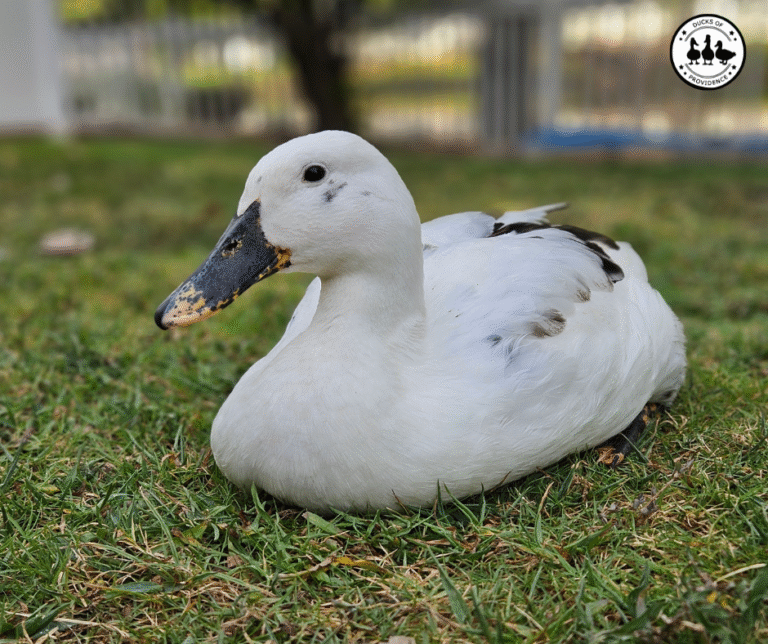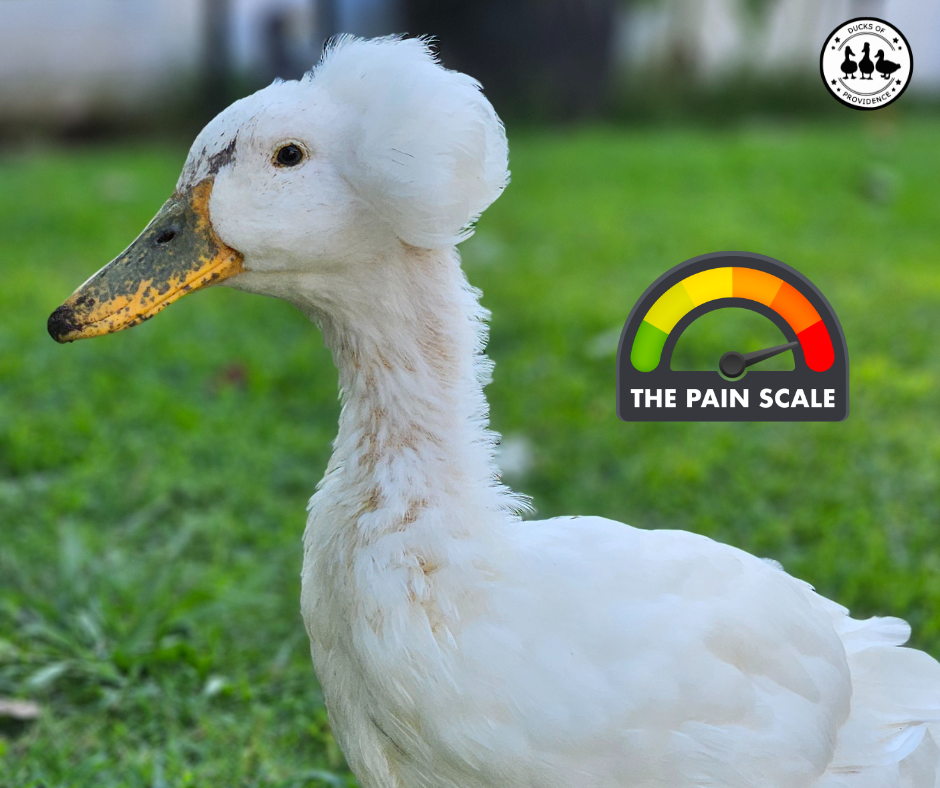
Is Your Duck in Discomfort? How to Recognize Pain in Ducks
Ducks are gentle and resilient animals, but like all creatures, they can experience pain and discomfort. What makes caring for them challenging is that they rarely show it openly. As prey animals, ducks have evolved to hide signs of weakness, which means even an attentive duck parent might miss the first subtle indicators that something is wrong.
Recognizing pain in ducks is more than an important part of responsible care. It is an act of empathy and understanding. Every small change in posture, behavior, or appetite can be a clue that your duck is not feeling well. By learning to read these signs, we can help our feathered companions feel safe, comfortable, and supported.
Over the years, observing my own flock has taught me how easily quiet suffering can go unnoticed. A duck that seems only a little quieter than usual may actually be in distress. Combining scientific knowledge about how birds perceive pain with careful daily observation helps us respond quickly and prevent prolonged discomfort.
In this post, we will explore what pain means for ducks, how they express it through behavior and body language, and what you can do to help them heal. Understanding avian pain will deepen your connection with your ducks and strengthen the trust that grows when they know you are paying attention.
Ducks of Providence is free, thanks to reader support! Ads and affiliate links help us cover costs—if you shop through our links, we may earn a small commission at no extra cost to you. Thanks for helping keep our content free and our ducks happy! 🦆 Learn more
Understanding Pain in Ducks
Ducks are often described as calm and stoic, but this quiet nature can make it difficult to recognize when they are hurting. In the wild, showing signs of weakness could make them easy targets for predators. This instinct to appear healthy and strong remains deeply ingrained, even in domestic ducks who live safely in our care. As a result, they tend to mask discomfort until it becomes more severe or impossible to hide.
From a scientific perspective, there is no doubt that ducks feel pain. Studies have confirmed that birds possess specialized nerve endings called nociceptors that detect harmful or painful stimuli, just as they do in mammals. These receptors send signals to the brain through the spinal cord, allowing the duck to perceive pain and react to it. Although a duck’s nervous system processes sensations slightly differently from ours, the overall mechanisms are remarkably similar.

It is also important to understand that pain in ducks can be both physical and emotional. Physical pain might result from injuries, infections, or chronic conditions such as arthritis or bumblefoot. Emotional or psychological distress can arise from loneliness, loss of a flockmate, or sudden environmental changes. In both cases, ducks express their discomfort through subtle shifts in behavior and posture that a caring observer can learn to recognize over time.
As duck keepers, we hold a unique advantage. We know our ducks individually and notice when something feels off. The first step toward helping them is acknowledging that they do experience pain and that understanding these signals can make a real difference in their well-being.
Why Detecting Pain in Ducks Can Be Challenging
Recognizing pain in ducks takes patience, attention, and experience. Unlike many other pets, ducks do not cry out or limp dramatically at the first sign of discomfort. Their survival instincts tell them to act as normally as possible, even when they are in pain. This makes it easy for early warning signs to go unnoticed until the condition has already progressed.
Another reason pain can be difficult to detect is that every duck has its own personality and baseline behavior. Some are naturally quiet or reserved, while others are very active or vocal. A behavior that looks concerning in one duck may be perfectly normal for another. Knowing what is typical for each of your ducks is the key to spotting small but meaningful changes.
Pain can also vary in how it appears, depending on whether it is acute or chronic. Acute pain happens suddenly, such as from a predator attack, injury, or infection. It usually causes an obvious change in behavior or movement. Chronic pain, on the other hand, develops slowly and might come from long-term issues like arthritis, bumblefoot, or reproductive problems. Ducks with chronic pain often adapt to their discomfort, showing only subtle signs such as reduced activity or less interest in bathing and foraging.
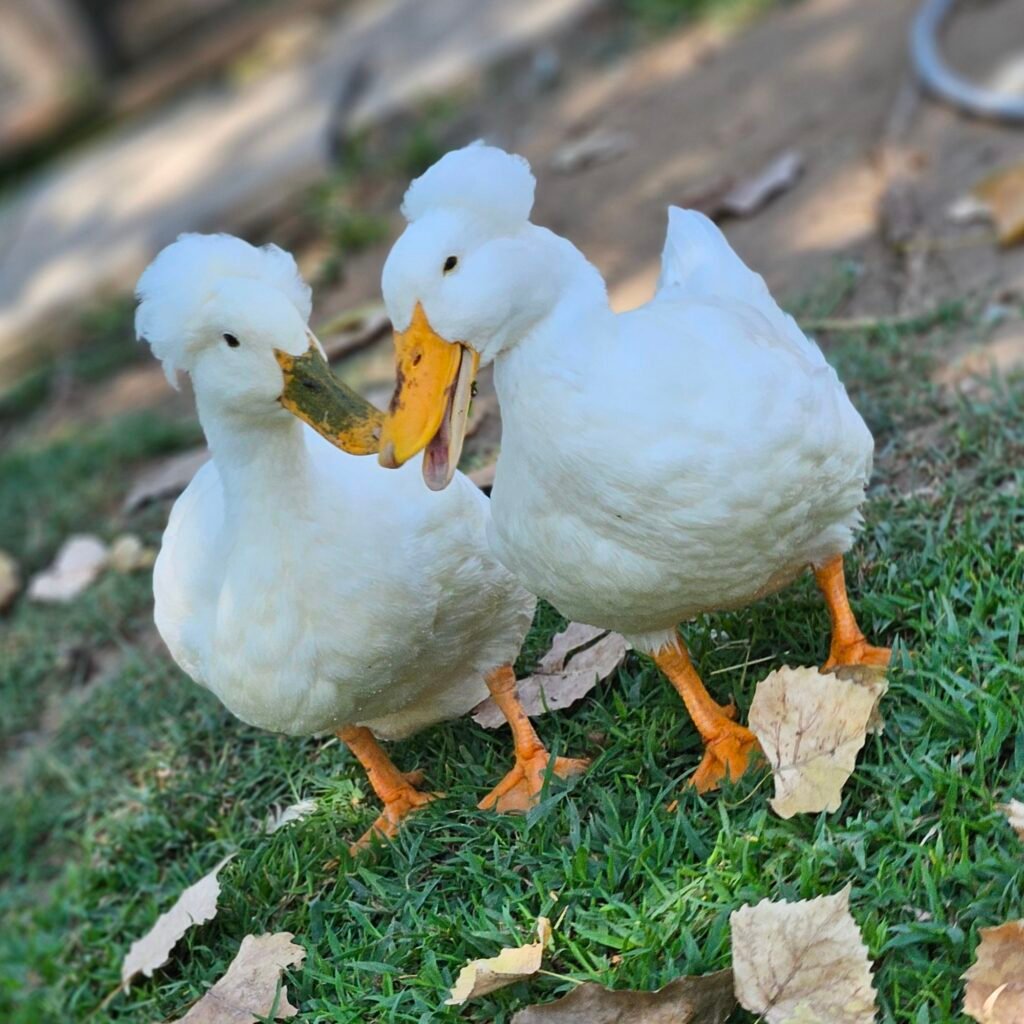
Another challenge is the way the flock reacts to a duck that is unwell. In the wild, a weak flock member increases the risk of attracting predators. This instinct carries over to domestic flocks as well. Ducks that show signs of pain or weakness may be bullied, pecked, or even pushed away by their companions. While this behavior seems harsh, it is a survival response deeply rooted in their nature. For duck keepers, it means that an injured or sick duck might not only suffer quietly but also face added stress from flock dynamics. Providing a calm, separate recovery space when needed can prevent further harm and give your duck time to heal safely.
Because of these challenges, it helps to observe your ducks daily and keep track of their usual habits. Knowing how they walk, preen, swim, and interact when they feel good will help you quickly notice when something seems off. Even a slight change in posture, appetite, or mood can be your duck’s way of saying that it needs help.
Behavioral Signs of Pain and Discomfort
Behavioral changes are often the earliest and most telling signs that a duck is in pain. Because physical symptoms can take time to appear, paying close attention to how your duck acts is one of the best ways to detect discomfort early. Ducks communicate through subtle body language and daily habits, and these quiet signals can speak volumes.
Withdrawal or Isolation
A duck that usually stays close to the flock may begin spending more time alone, away from the group. It might choose a shaded corner of the run, a quiet area in the coop, or simply keep to itself during feeding and swimming times. This behavior often reflects the duck’s natural instinct to conserve energy and avoid conflict when feeling unwell.
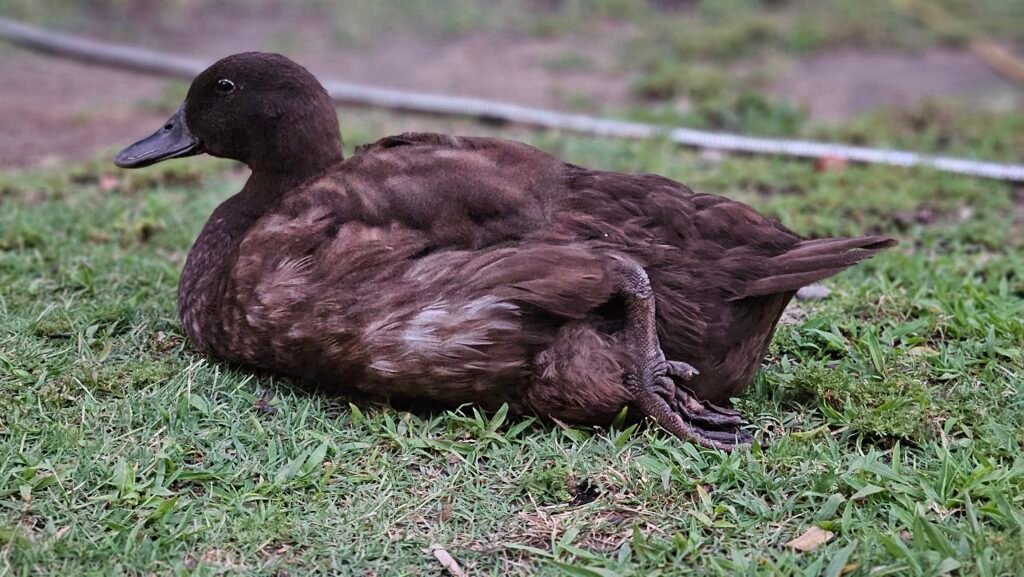
Reduced Activity or Movement
A duck in discomfort often moves less than usual. You may notice shorter walks, slower steps, or an overall reluctance to explore, bathe, or play. Some ducks appear tired or may spend more time sitting, especially if their feet, joints, or abdomen are sore. If your normally active duck suddenly seems sluggish or uninterested in favorite activities, that is a sign to look closer.
Loss of Appetite or Change in Eating Habits
Healthy ducks are eager eaters. A sudden drop in appetite, refusing treats, or picking at food can be an early signal of pain or illness. Some ducks will still approach food, but only nibble a little before walking away. Keep an eye on how quickly they come to the feeder and how much they actually eat.
Changes in Temperament
Pain can influence how your duck interacts with you and its flockmates. A usually calm duck might hiss, nip, or resist being picked up. Others may become unusually quiet or withdrawn. These behavior shifts are often misread as moodiness but can actually be signs of discomfort or stress.
Altered Vocalizations
Every duck has its own “voice,” and sudden changes in tone or frequency can indicate distress. Some ducks become noticeably quieter, while others vocalize more often, especially if touched in a painful area. Listen for quacks that sound hoarse, strained, or unusually high-pitched.

Lack of Preening or Bathing
Healthy ducks are meticulous groomers. When a duck stops preening, avoids water, or lets its feathers become dull and unkempt, this can be a red flag. Pain, fatigue, or internal illness often causes ducks to neglect self-care behaviors like bathing and feather maintenance.
Trusting Your Instincts
No one knows your ducks better than you do. When you spend time with them each day, you naturally learn their routines and quirks. If something feels “off,” even without a clear reason, trust that instinct and observe closely. Often, small behavioral shifts are your duck’s quiet way of asking for help.
Physical Signs of Pain
While behavioral changes often appear first, physical symptoms can confirm that your duck is in pain. These visible clues range from small changes in posture to noticeable swelling or difficulty moving. Because ducks are skilled at hiding discomfort, even subtle physical differences deserve attention. Observing your duck’s body carefully and gently can help you spot these signs early and seek help before the pain worsens.
Limping or Uneven Movement
Limping is one of the most common signs of pain in ducks. It can result from injuries, sprains, bumblefoot, or joint problems such as arthritis. A duck that favors one leg, walks stiffly, or hesitates to stand for long periods is likely experiencing pain. Check the feet and legs for swelling, cuts, or heat, and make sure the surface they walk on is soft and dry.
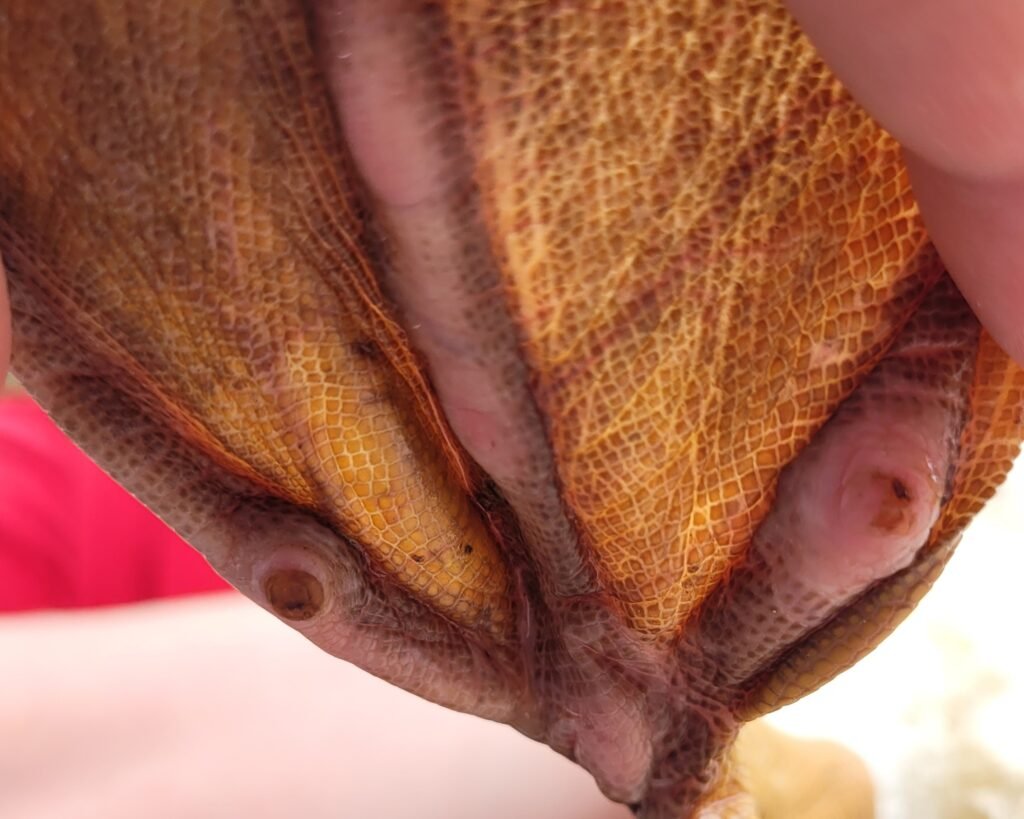
Swelling, Warmth, or Redness
Any visible swelling or warmth around the feet, joints, or body can indicate inflammation or infection. Ducks may also react when those areas are gently touched. Always inspect your duck’s feet carefully, as sores or scabs can be early signs of bumblefoot or other painful conditions.
Changes in Posture or Balance
A healthy duck stands tall and balanced. When in pain, a duck may appear hunched, sit more often, or keep its head tucked close to the body. Some may shift their weight repeatedly or have trouble staying upright. Tail drooping, droopy wings, or uneven weight distribution are all clues that your duck is uncomfortable.
Fluffed or Unkempt Feathers
Fluffed feathers are not always a sign of contentment. When a duck’s feathers stay puffed for long periods, especially when combined with lethargy or loss of appetite, it may signal illness or pain. Ducks that stop preening also tend to look less glossy, with dull, uneven feathers that can stick together.
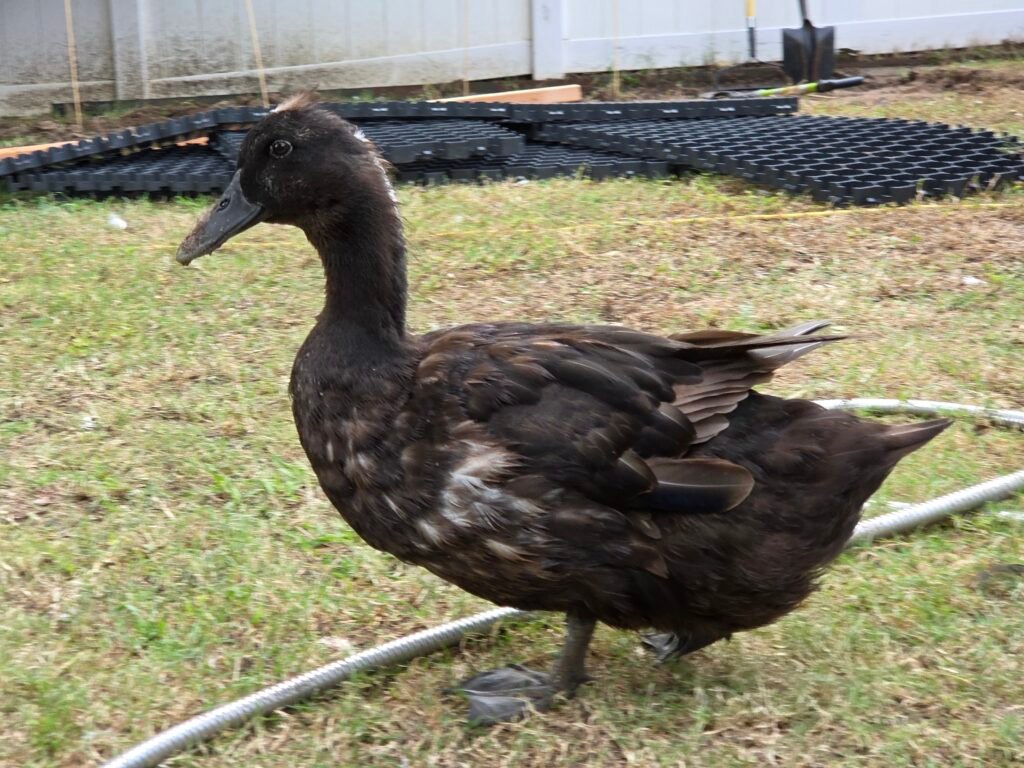
Changes in Breathing
Watch for rapid, shallow, or open-mouth breathing, especially when your duck is resting. Pain, stress, or internal illness can cause irregular breathing patterns. If your duck appears to struggle for air or breathes heavily without exertion, immediate veterinary attention is needed.
Abnormal Tail or Wing Position
A tail held low, drooping wings, or difficulty lifting the wings can all indicate pain or weakness. Ducks with injuries may hold one wing lower than the other or avoid spreading it during preening. These signs can point to joint pain, muscle strain, or even fractures that require prompt care.
Unusual Body Temperature
When touched gently, your duck’s body should feel warm but not hot. Excessive warmth in one area may indicate inflammation or infection, while an overall cold body temperature can signal shock or severe illness. In both cases, your duck needs veterinary attention right away.
Changes in Poop
Although not always directly tied to pain, changes in droppings often accompany discomfort or illness. Diarrhea, very watery stool, or unusual color can suggest infection, stress, or internal pain. Monitoring your duck’s droppings is a helpful way to track health changes over time.
Physical signs provide valuable insight into your duck’s wellbeing, but they should always be interpreted alongside behavior. The more you observe your flock, the easier it becomes to recognize when something feels different. Acting early can make recovery faster and far less stressful for your duck.
Signs of Pain in Ducks At a Glance
Recognizing pain in ducks often means paying attention to both their body and their emotions. Some signs are easy to see, like limping or swelling, while others appear more quietly through changes in mood or behavior. Each duck expresses discomfort a little differently, but once you know what to look for, these signals become much easier to spot. The table below offers a quick reference for identifying common physical and emotional signs of pain in ducks.
| Type of Sign | Common Indicators | What It Might Mean |
|---|---|---|
| Physical Signs | Limping, slow walking, or sitting often | Pain in legs, feet, or joints such as bumblefoot or arthritis |
| Swelling, redness, or warmth on the body | Inflammation, infection, or injury | |
| Fluffed or dull feathers, lack of preening | Illness, fatigue, or chronic pain | |
| Drooping wings or tail held low | Weakness, muscle strain, or systemic illness | |
| Rapid or open-mouth breathing | Pain, respiratory distress, or internal pressure | |
| Refusal to swim or bathe | Soreness, foot pain, or low energy | |
| Changes in droppings (color or texture) | Digestive upset, infection, or internal discomfort | |
| Weight loss or poor body condition | Chronic pain, poor appetite, or systemic disease | |
| Emotional Signs | Withdrawal or isolation from the flock | Stress, depression, or emotional pain |
| Unusual aggression or irritability | Discomfort, fear, or anxiety from pain | |
| Quietness or lack of normal vocalization | Fatigue or general malaise | |
| Loss of interest in food, play, or surroundings | Emotional distress or illness-related lethargy | |
| Restlessness or pacing | Anxiety, discomfort, or environmental stress | |
| Excessive grooming or feather picking | Stress, pain, or boredom | |
| Staying close to you for comfort or reassurance | Seeking safety and emotional support |
Internal Pain: When the Signs Are Harder to See
Some of the most serious types of pain in ducks are not visible from the outside. Conditions such as egg binding, reproductive infections, or internal injuries often produce very subtle signs that can be mistaken for fatigue or mild illness. Because ducks instinctively mask these symptoms, paying attention to small changes in posture, breathing, or movement can make all the difference.
Internal pain is often more complex than external injuries because it involves organs that we cannot easily inspect. In these cases, observation, experience, and timely veterinary care are essential.
Straining or Tail Pumping
A duck that appears to strain or pump its tail repeatedly may be experiencing pain related to the reproductive or digestive system. This behavior is especially concerning in females, as it can signal egg binding or a soft-shelled egg that is difficult to pass. The duck may stand very still, stretch her neck, or make quiet grunting sounds while straining. Immediate veterinary attention is needed in these cases.

Swollen or Firm Abdomen
If you gently place your hand under your duck’s belly and feel unusual firmness or swelling, it could indicate internal fluid buildup, reproductive issues, or infection. A duck with abdominal pain might also stand with her legs slightly apart, avoid walking, or react when touched in that area.
Loss of Appetite and Energy
When ducks experience internal pain, they often eat and drink less. You may notice your duck visiting the feeder but leaving quickly or refusing favorite treats. Along with reduced appetite, ducks with internal discomfort often appear tired, spending more time resting or sitting than usual.
Unusual Breathing or Panting
Internal pain can make breathing more difficult. You might notice open-mouth breathing, heavier panting, or slight head bobbing with each breath. These signs are common in ducks suffering from internal infections, respiratory distress, or egg-related pain.
Reluctance to Move or Stand
A duck in internal pain may stay in one place for long periods and appear hesitant to walk. Some will shift weight from side to side or stand very upright and still to relieve abdominal pressure. If your duck seems to avoid moving or sits awkwardly, it may be in discomfort.
Change in Egg Laying or Droppings
Female ducks with internal pain may stop laying eggs or produce irregular shells. At the same time, droppings may become sparse or watery. A sudden pause in egg laying, especially in an otherwise healthy female, always deserves a closer look.
Internal pain can quickly become serious, especially when related to the reproductive system. If your duck shows any of these signs, do not wait to see if it improves. Contact an avian veterinarian as soon as possible. Early intervention not only prevents complications but can also save your duck’s life.
How Vets Assess Pain in Ducks
Recognizing pain in ducks at home is important, but confirming the cause and treating it properly requires professional evaluation. Avian veterinarians are trained to read subtle clues and use diagnostic tools to pinpoint the source of discomfort. Because ducks often hide their symptoms until the pain is advanced, seeking veterinary care early gives the best chance for recovery.
A visit to the vet may seem stressful for both duck and owner, but it can bring valuable insight into what your feathered friend is experiencing. Understanding how vets assess pain helps you know what to expect and how to support your duck throughout the process.

Observation and Behavioral Assessment
The first step is usually quiet observation. The vet will watch how your duck stands, moves, and breathes before handling it. They note posture, gait, balance, vocalization, and overall alertness. A duck that fluffs its feathers, sits with eyes half-closed, or avoids standing is often in discomfort.
Vets also rely on information from you. Describing when the symptoms started, what changes you noticed, and whether the duck is eating, bathing, or laying normally provides important context that helps them narrow down possible causes.
Physical Examination
Next comes a careful hands-on examination. The vet checks for swelling, heat, or tenderness, starting from the head and moving toward the feet. They may gently extend the wings, feel the abdomen for firmness, or inspect the feet and legs for signs of bumblefoot or injury.
During this step, the duck’s reaction to touch offers valuable information. Pulling away, vocalizing, or tensing when a certain area is examined can indicate pain in that specific region.
Diagnostic Imaging
If the cause of pain is not visible, the vet may recommend imaging such as X-rays or ultrasound. These tools help identify fractures, egg binding, internal infections, or fluid buildup. For reproductive or digestive issues, an ultrasound can reveal eggs, masses, or inflammation that are not detectable from the outside.
Blood Tests and Lab Work
Blood tests can help identify inflammation, infection, or organ-related pain. Elevated white blood cell counts often suggest an immune response to infection, while changes in liver or kidney values may point to internal problems. These results guide the vet in choosing the right treatment and medications.
Pain Management and Treatment
Once the cause of pain is identified, the vet will decide how to manage it safely. Common medications include anti-inflammatory drugs such as meloxicam, which is often used in birds at precise doses. Antibiotics or antifungals may be prescribed if infection is present. In some cases, supportive care like fluids, warmth, or temporary rest is just as important as medication.
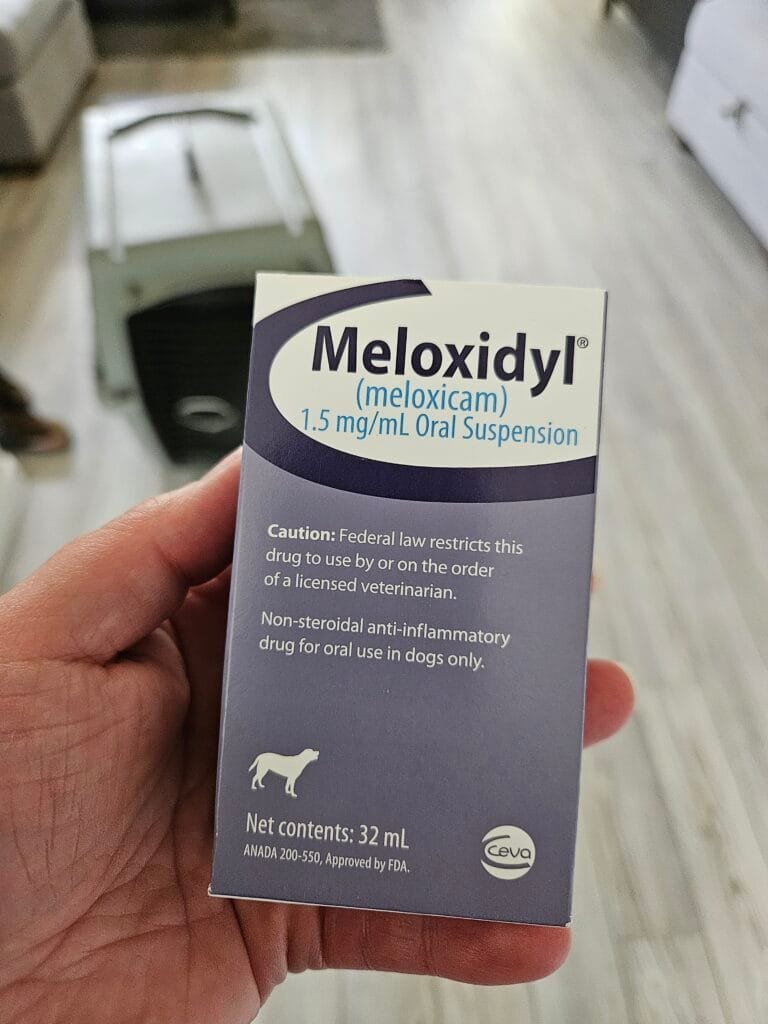
Follow-Up and Monitoring
Pain management does not end with the first visit. Your vet may ask for follow-up observations or rechecks to ensure the duck is improving. Monitoring appetite, droppings, and activity levels at home helps track recovery progress. Keeping a simple daily log can make it easier to share updates with your vet.
Understanding how veterinarians assess pain empowers duck keepers to work as partners in care. The more detail you can provide about your duck’s normal habits and recent changes, the better your vet can help relieve discomfort and prevent future issues.
How You Can Help a Duck in Pain
When a duck is hurting, your calm and attentive care can make a real difference in how quickly it recovers. Ducks are sensitive animals that respond strongly to their environment and to your presence. Offering comfort, safety, and gentle support helps them heal physically and emotionally. While professional veterinary care is always essential for diagnosing and treating pain, there is a lot you can do at home to ease their discomfort and prevent further stress.
Create a Calm and Quiet Space
Pain can make ducks anxious or easily startled. Keeping your duck in a quiet area away from loud noises, predators, and flock tension helps it rest and recover. A small pen or section of the coop lined with clean, soft bedding works well. Ensure the area stays dry, warm, and shaded from direct sun.
If your duck is bonded to a flockmate, allowing them to see or hear each other can provide comfort. Ducks often recover better when they do not feel isolated, but avoid crowding or direct interaction if it causes stress or if separation is required for treatment.

Make Food and Water Easily Accessible
Place food and water within easy reach so your duck does not have to walk or stretch far. Offer favorite greens or small treats to encourage eating, and make sure water dishes are shallow to prevent accidental spills or strain. If your duck is weak, you can gently lift its bill to help it drink small amounts of water, but do not force it.
Sometimes offering wet mash made from their regular feed mixed with warm water can stimulate appetite and help them stay hydrated.
Maintain Soft and Clean Bedding
Pain can worsen if your duck rests on hard or dirty surfaces. Soft, dry bedding such as straw, pine shavings, or washable fleece liners helps protect sensitive feet and joints. Change the bedding daily to prevent bacterial growth, especially if your duck is spending most of its time sitting or lying down.
Provide Warmth and Gentle Support
A duck in pain or recovering from illness often struggles to regulate body temperature. Providing gentle warmth through a heat lamp set at a safe distance or a heating pad under part of the enclosure can make a big difference. Always ensure your duck has enough space to move away if it becomes too warm.
Limit Movement if Advised
If your vet recommends rest, keep your duck’s activity limited for a few days. Avoid swimming time or free-ranging until the pain improves. Short, supervised breaks outdoors can be beneficial for mental well-being, but safety and rest should come first.
Offer Gentle Companionship
Your calm presence can be incredibly reassuring. Sit quietly nearby, talk softly, or offer gentle strokes if your duck enjoys being handled. Familiar voices and routines can ease stress, reminding your duck that it is safe and cared for.
Follow the Vet’s Instructions Carefully
If your duck is on medication, give the exact dose at the prescribed times and complete the full course, even if the duck appears better. Keep a record of when you administered the medication and any changes in behavior or appetite.
Pain management in ducks often requires patience. Improvement can take several days, especially after injuries or internal conditions. Trust the process, monitor progress, and contact your vet if the pain worsens or new symptoms appear.
Caring for a duck in pain is one of the most compassionate things a duck parent can do. Your understanding, consistency, and gentle attention create the conditions for healing and help your duck regain its comfort and trust.
When to Call the Vet
Even the most observant duck keeper cannot always tell how serious a problem is. Some conditions that cause pain can worsen quickly or even become life-threatening if left untreated. Knowing when to contact your veterinarian can make all the difference between a simple recovery and a serious emergency. When in doubt, it is always better to call and describe what you are seeing. A vet can guide you on whether your duck needs to be seen right away or if you can monitor it safely at home.
Loss of Appetite or Energy
If your duck stops eating or drinking for more than twenty-four hours, this is a clear sign that something is wrong. Ducks that sit still for long periods, refuse treats, or seem unusually quiet are likely experiencing pain or illness that needs evaluation.
Difficulty Walking or Standing
Limping, falling over, or sitting constantly can indicate joint pain, foot injuries, or internal discomfort. If your duck cannot stand or walk normally, it needs veterinary attention as soon as possible.
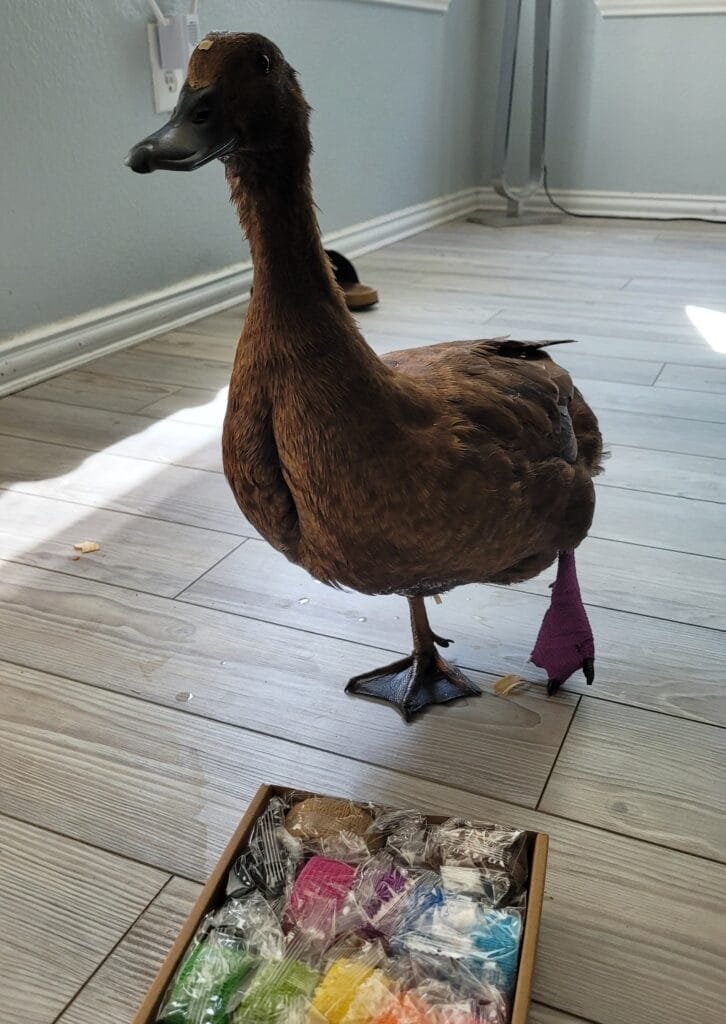
Labored or Rapid Breathing
Breathing changes are among the most urgent warning signs. Open-mouth breathing, gasping, wheezing, or heavy panting when at rest can indicate respiratory infection, internal pain, or fluid buildup. This always requires immediate care.
Swelling, Wounds, or Bleeding
Visible injuries or swelling should never be ignored. Even small cuts or bumblefoot sores can become infected and cause significant pain. If you see bleeding that does not stop, or swelling that feels warm or firm, seek help right away.
Straining or Suspected Egg Binding
If a female duck is straining, standing still with her tail pumping, or appears distressed, she could be egg-bound. This is an emergency. Do not attempt to massage or apply heat without guidance from your vet, as this can worsen the situation.
Sudden Behavioral Change
A duck that suddenly becomes fearful, aggressive, or withdrawn often does so because of pain. Changes in personality that appear overnight can signal serious discomfort or internal illness.
Prolonged Fluffed Feathers or Lethargy
When your duck remains fluffed up, sleeps more than usual, or seems uninterested in its surroundings for more than a day, it is time to call the vet. These are general signs of illness or pain that should not be ignored.
Quick and informed action can save your duck from unnecessary suffering. If you are unsure, describe your duck’s behavior, breathing, and appetite to your veterinarian. They can help assess the urgency of the situation and recommend next steps. Early intervention almost always leads to a better outcome and helps your duck return to its happy, healthy self sooner.
Preventing Pain in the First Place
Preventing pain is one of the most important parts of responsible duck care. While some health issues cannot be avoided entirely, many sources of discomfort can be reduced with good nutrition, proper housing, and daily observation. By creating a safe, enriching, and healthy environment, you can help your ducks live comfortable and joyful lives while avoiding many painful conditions altogether.

Provide a Balanced and Nutritious Diet
Good nutrition supports every part of your duck’s health, from strong bones to healthy feathers and reproductive balance. Offer a complete duck feed appropriate for their age and lifestyle, along with safe vegetables, greens, and grains. Supplement with calcium when needed for laying females, and provide grit to help with digestion. Avoid feeding too many treats, as excess calories can lead to obesity and joint problems that cause pain over time.
Keep the Environment Clean and Dry
Moisture and mud are among the biggest causes of foot and leg problems in ducks. Keeping their living area dry with regular cleaning and proper drainage helps prevent infections such as bumblefoot. Use soft, clean bedding and change it often. Check for wet spots near water bowls or pools, and refresh the area frequently to stop bacteria from spreading.
Ensure Safe and Stable Surfaces
Hard, uneven, or rough flooring can lead to sore feet or joint strain. Choose comfortable surfaces such as grass, sand, or soft turf. Avoid concrete or sharp gravel, which can create pressure points that cause pain. For indoor ducks or those recovering from injury, fleece pads or soft mats work well for extra comfort.
Encourage Gentle Exercise
Ducks need regular movement to stay healthy, but overexertion can cause strain. Give them space to walk, forage, and swim daily, but avoid forcing them to move if they appear tired or sore. Swimming is especially helpful for joint health because it supports joint weight while safely strengthening muscles.
Maintain Proper Weight
Overweight ducks are more likely to suffer from leg pain, arthritis, and reproductive issues. You can prevent this by feeding measured portions, providing enrichment that encourages natural foraging, and limiting treats. Observe body shape regularly; a duck that waddles stiffly or has trouble standing may need a dietary adjustment.
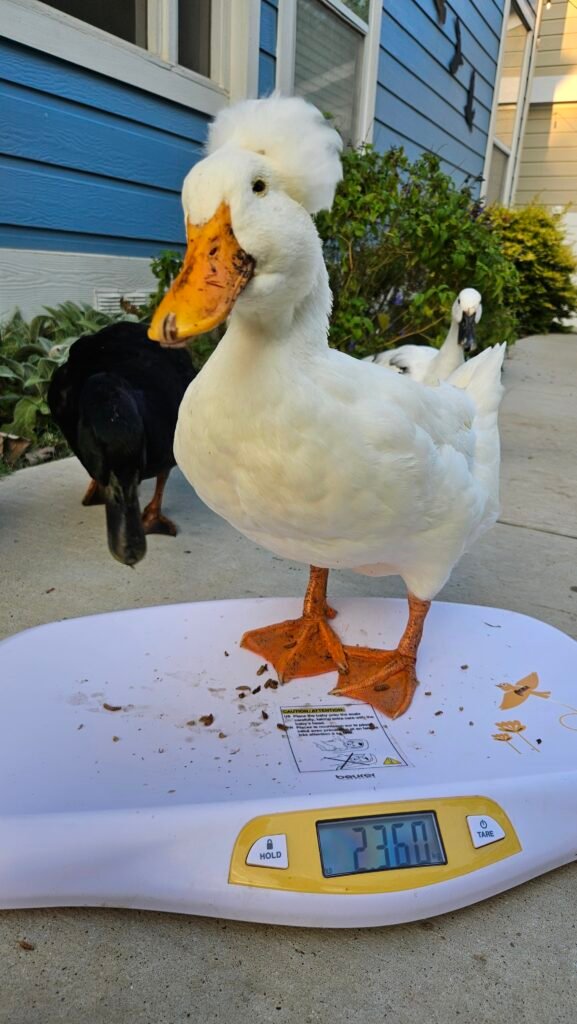
Practice Regular Health Checks
Take time each week to observe your ducks closely. Look at their eyes, feathers, feet, and posture. Watch how they move and interact with each other. Early detection of small injuries, swelling, or changes in appetite often prevents minor issues from turning into painful conditions.
Predator-Proof and Injury-Proof Their Space
Painful injuries often happen when ducks are startled or attacked. Secure the coop and run with hardware cloth, cover the top to block aerial predators, and close your ducks safely at night. Remove sharp objects, wire edges, or anything they might catch a foot or wing on.
Provide Companionship and Enrichment
Pain is not always physical. Ducks can experience emotional distress if they feel lonely or bored. Keeping them with other ducks, offering toys, mirrors, or foraging challenges, and spending time with them daily all support their emotional wellbeing and reduce stress-related behaviors.
Preventing pain takes consistency rather than perfection. Small, thoughtful habits, clean bedding, a healthy diet, and a watchful eye go a long way in keeping your ducks happy and pain-free. In return, they reward you with trust, companionship, and the quiet joy that comes from knowing they feel safe and cared for.
FAQ: Recognizing and Managing Pain in Ducks
Even experienced duck keepers often have questions about how ducks feel and express pain. Because their behavior can be subtle, it helps to understand what is normal, what is not, and how to respond safely. Here are some common questions and clear, science-based answers to help you care for your flock with confidence.
Do ducks feel pain like humans do?
Yes, they do. Ducks have pain receptors and nerve pathways very similar to those in mammals. Their brains process pain signals differently, but research shows that they experience both the physical sensation and the stress that comes with it. The main difference is that ducks rarely show it outwardly, which is why observation and awareness are so important.
Can I give my duck human pain medication?
No. Never give ducks over-the-counter medications meant for humans, such as aspirin, ibuprofen, or acetaminophen. These drugs can be toxic to birds, even in small doses. Always consult an avian veterinarian for proper pain relief options. Vets often prescribe medications like meloxicam, which is safe for birds when dosed correctly.
How can I comfort my duck after an injury or surgery?
Create a calm, warm, and quiet space for recovery. Keep your duck on soft bedding, limit movement as advised by the vet, and offer easily accessible food and water. Gentle reassurance from you can also make a difference. Many ducks find comfort in familiar voices and calm presence. Follow all post-treatment care instructions carefully.
How long does it take for a duck to recover from pain?
The recovery time depends on the cause and severity of the pain. Minor injuries might heal within a few days, while internal issues or infections can take weeks. Consistent care, proper medication, and close observation help recovery go smoothly. If you do not see improvement or notice new symptoms, contact your vet.
How can I tell the difference between normal tiredness and pain?
Ducks sometimes rest more after swimming or in hot weather, which is normal. Pain-related lethargy usually comes with other signs, such as fluffed feathers, loss of appetite, or changes in posture or breathing. If your duck remains still or withdrawn longer than usual, it is safest to assume it may be unwell and observe more closely.
Do ducks hide pain on purpose?
Yes, but not consciously. Hiding pain is an instinctive behavior that helps them avoid predators in the wild. Domestic ducks have kept this instinct even though they are safe with us. This is why even small changes, like a quiet duck skipping bath time, deserve attention.
Should I separate a duck that is in pain from the flock?
That depends on the situation. If the duck is being bullied or cannot compete for food and space, temporary separation is helpful. However, total isolation can cause stress. Keeping your duck within sight or hearing of the flock while still giving it a quiet recovery area often works best.
Can emotional pain affect ducks too?
Yes. Ducks form strong social bonds, and the loss of a flockmate or sudden changes to their environment can cause emotional distress. These experiences can look similar to physical pain, with signs like withdrawal or loss of appetite. Offering comfort, time, and companionship helps them recover emotionally.
Taking the time to learn these signs and responses allows you to notice pain early, act quickly, and strengthen the trust you share with your ducks.
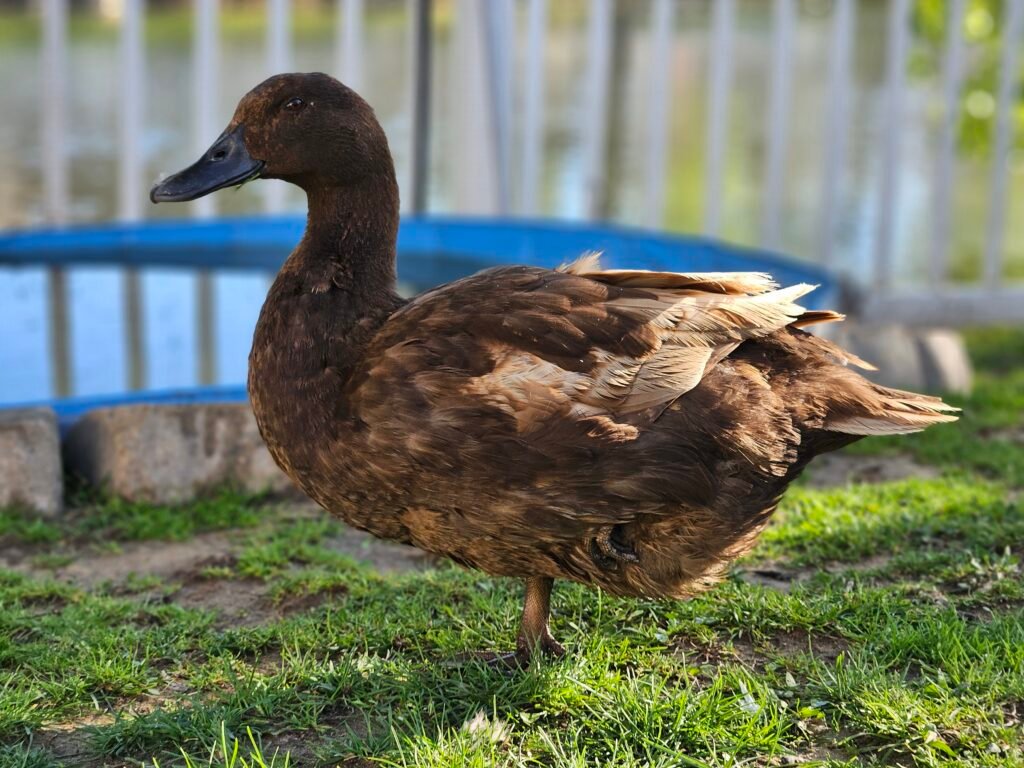
Final Thoughts
Recognizing pain in ducks is both a science and an art. It requires understanding their biology but also paying attention to the quiet ways they communicate. Ducks rarely show obvious signs of pain, but they reveal discomfort through small details such as how they move, how they eat, and how they rest. Learning to notice these subtle changes is one of the most meaningful parts of caring for them.
When we take the time to observe and respond with empathy, we strengthen the bond we share with our ducks. They learn that they can trust us, and in return, we gain a deeper understanding of their needs. Whether it is an injured foot, a hidden infection, or quiet emotional pain, every act of care, from clean bedding to calm reassurance, helps them feel safe and supported.
As duck keepers, we have the privilege and responsibility of being their voice. Our patience, awareness, and gentle attention can turn discomfort into comfort and fear into calm. The more we understand their wellbeing, the better we can ensure that our beloved companions live peaceful, healthy, and happy lives.
Related Articles
- How to Conduct a Duck Health Check: A Comprehensive Guide
- Safely Medicating Ducks: A Guide for Pet Duck Owners
- Emergency Care for Ducks After a Predator Attack: First Aid, Treatment, and When to See a Vet
- 16 Common Duck Health Conditions You Should Know About
- 31 Must-have Items for Your Pet Duck First Aid Kit
- Duck Anatomy: A Complete Guide for Pet Owners

